Beautiful Britain Series
The ‘Beautiful Britain’ series depicting seaside and country resorts was produced by John Waddington Ltd for the Great Western Railway and London and North Eastern Railway between 1924-1939.
The traditional way of selling playing cards was through the stationery trade and to advertisers. Mr Clarrie Hirst from Waddington’s sales and marketing department came up with the idea of selling playing cards carrying an advertisement to the stationery trade. This became the basis of Waddington’s ‘Beautiful Britain’ playing cards which depicted scenes of seaside and country resorts. The first ‘Beautiful Britain’ series was introduced in August 1924, subsidised to begin with by the Great Western Railway. Packs carried the name or initials on the reverse with monochrome photographs in sepia or green of popular scenic locations on the the railway’s itinerary. This enabled beautifully printed playing cards to be sold through the stationery trade at a very competitive price due to this advertising.
Above: scenic back designs for the Great Western Railway printed by John Waddington Ltd, 1924.
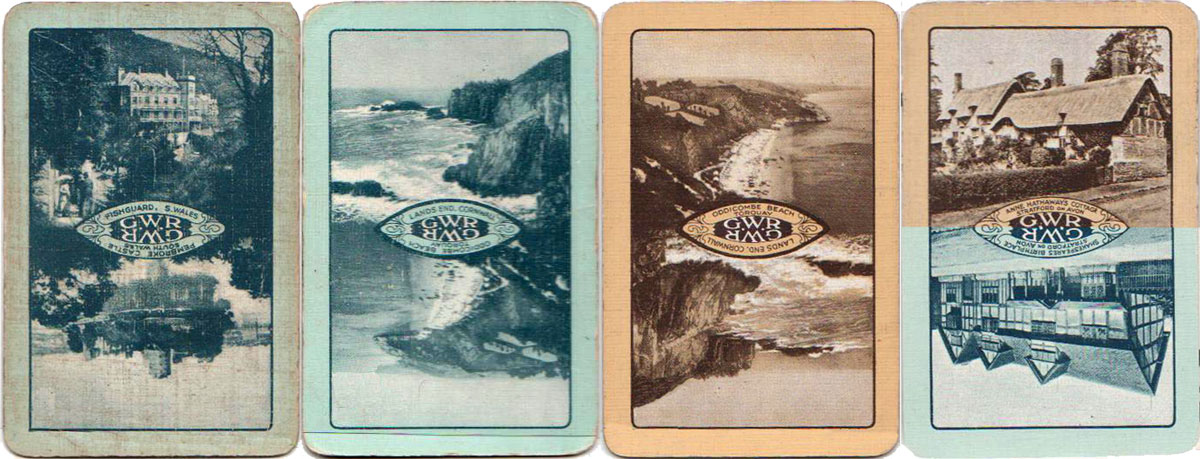
Above: a series of ‘Beautiful Britain’ backs sponsored by the Great Western Railway, published in 1924 showing a different scene at each end in either sepia or green. 1) Fishguard - Pembroke Castle, S. Wales. 2 & 3) Land’s End, Cornwall - Oddicombe Beach, Torquay. 4) Shakespeare’s Birthplace - Anne Hathaway's Cottage, Stratford-on-Avon.
This project was very successful and contributed to Waddington’s rapid growth in the playing card field and to becoming competitors to the established De la Rue business. However, the Great Western Railway withdrew their sponsorship in 1925 but the series continued to be subsidised by the London and North Eastern Railway until 1929. New designs were produced by artists such as Austin Cooper & Tom Purvis for the new railway itinerary, printed in colour and with ornamental panels at each end, including Scarborough, Norwich, Cromer, the Yorkshire Coast, North Berwick, Edinburgh, Royal Deeside, Clacton-on-Sea, Fort William, Norfolk Broads, and York.
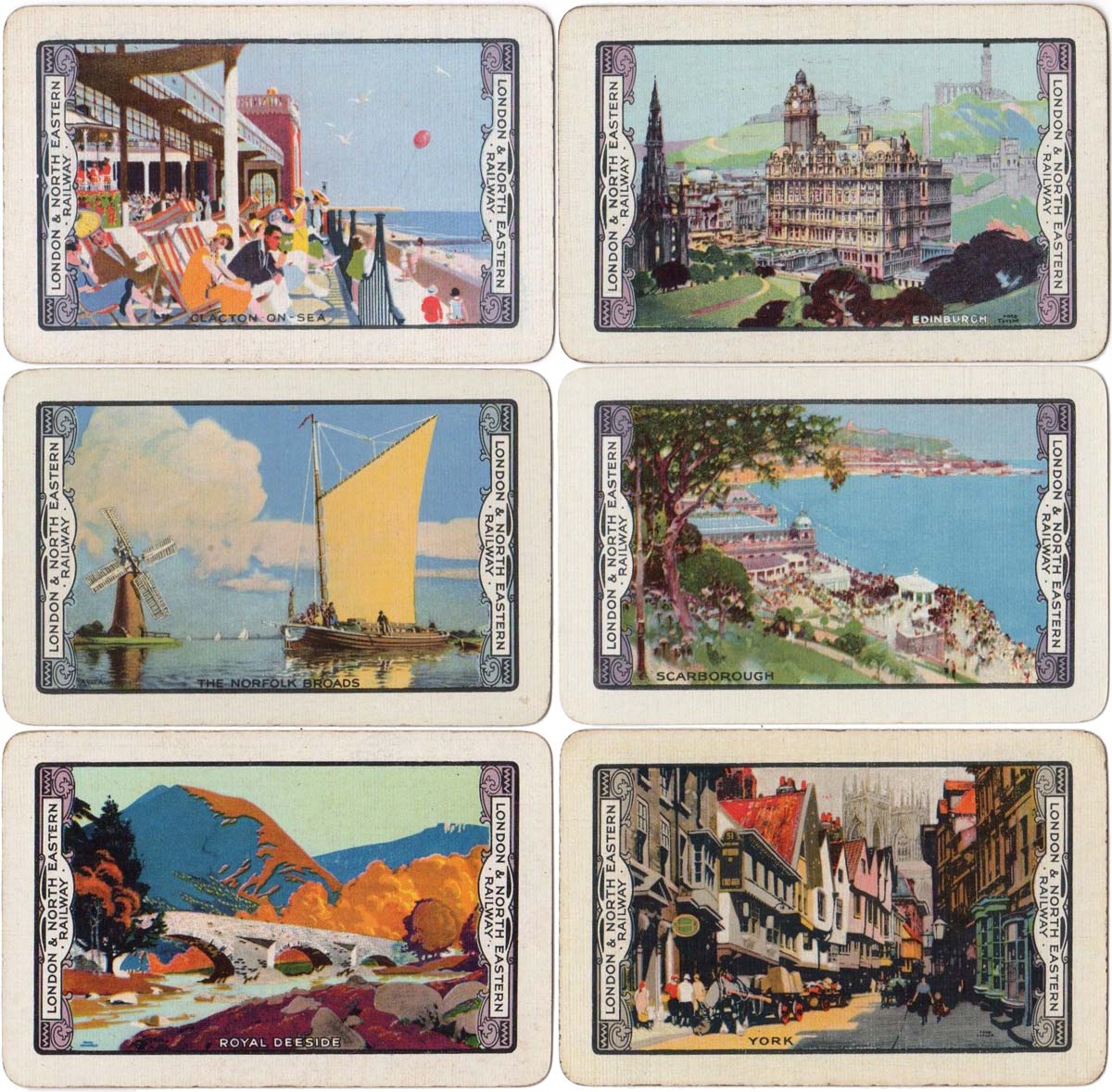
Above: ‘Beautiful Britain’ backs sponsored by the London and North Eastern Railway printed in colour and with the wording in a scroll, 1925-26.
A second type of design for the L.N.E.R. was also printed in colour but with the wording inside a black border at each end. Designs known from this series include: Caister Castle, Forth Bridge, Scarborough, The Trossachs and Whitby.
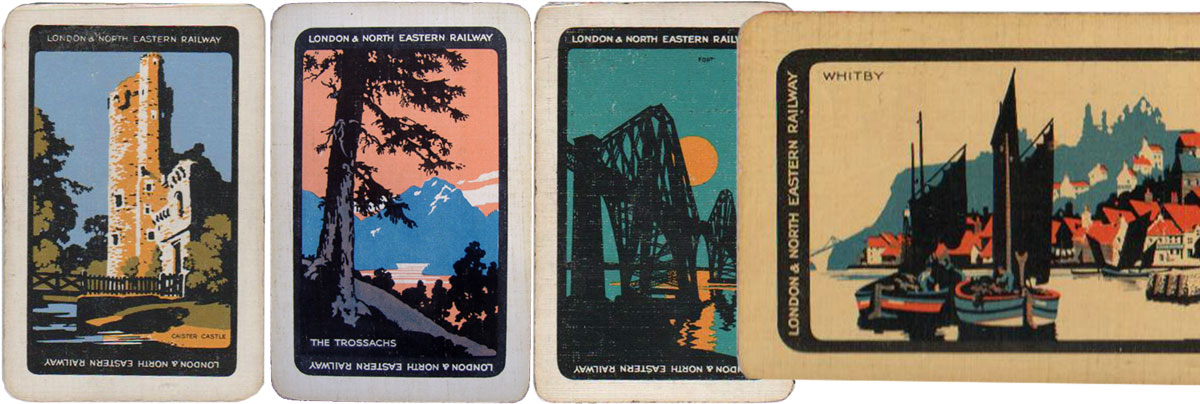
Above: ‘Beautiful Britain’ backs sponsored by the London and North Eastern Railway printed in colour and with the wording inside the border, 1926.
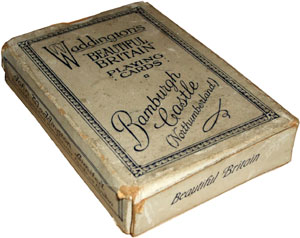
The General Strike in 1926 had adversely affected Waddington’s well-being and in 1927 the more expensive process of colour printing was replaced with monochrome designs in sepia or blue-green on a lighter background. These monochrome designs were introduced in two different styles from etchings, mostly by Frank Henry Mason, with dotted borders or continuous borders. Scenes in this style include: Bamburgh Castle, Bridlington, Lowestoft, Newcastle-on-Tyne, Whitby, York [by Fred Naylor], Royal Deeside [by Sidney Lee R.A.], Houses of Parliament, Cruden Bay Aberdeenshire, Felixstowe, Harrogate, Scarborough [by Frank Newbould], Richmond Yorkshire, Hungerford Bridge London and Carlton Hill Edinburgh.
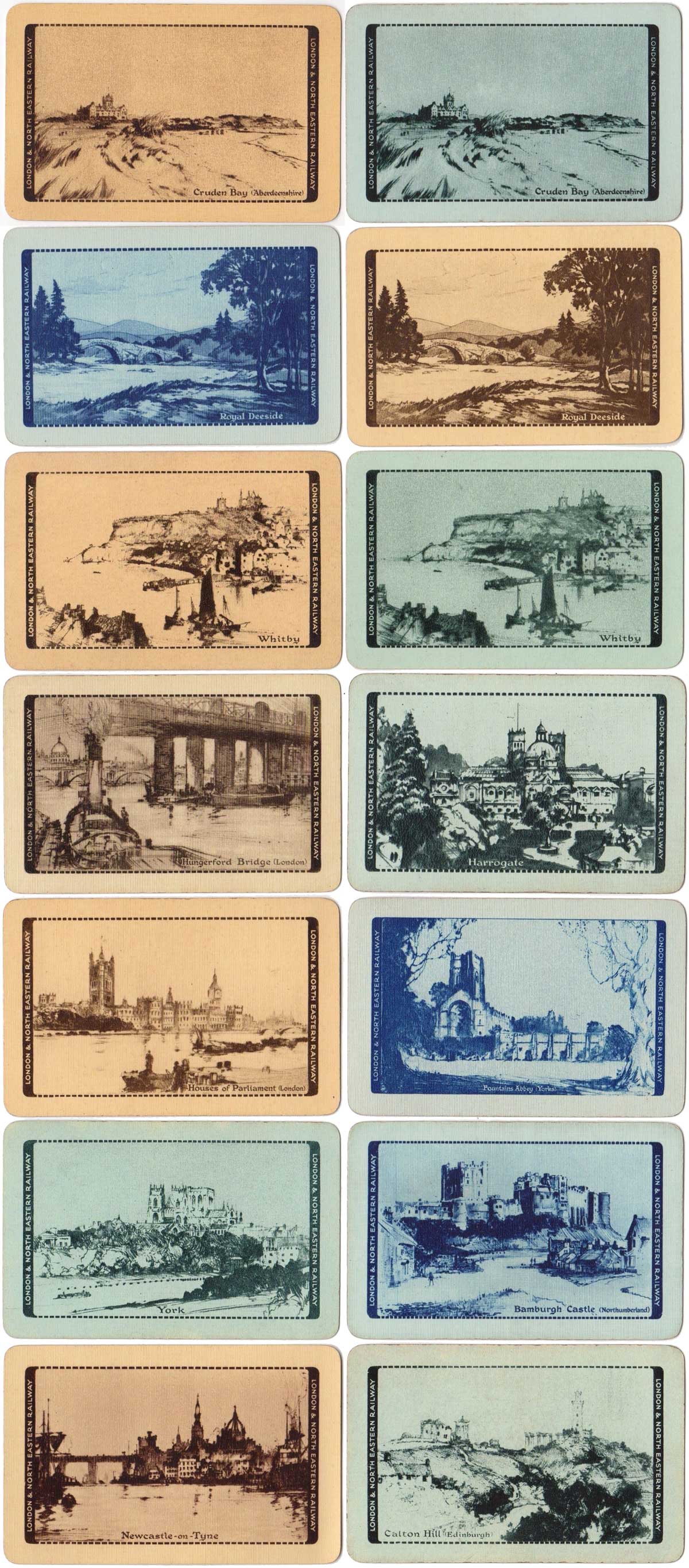
Above: ‘Beautiful Britain’ backs based on etchings by Frank Henry Mason, sponsored by the London and North Eastern Railway and printed in monochrome, 1927-29.
A special ace of spades was produced for the L.N.E.R. in two slightly different versions. The second version has a small scroll at the base of the spade motif with the legend “Kings Cross for Scotland shortest and quickest” which was one of their advertising slogans at that time→
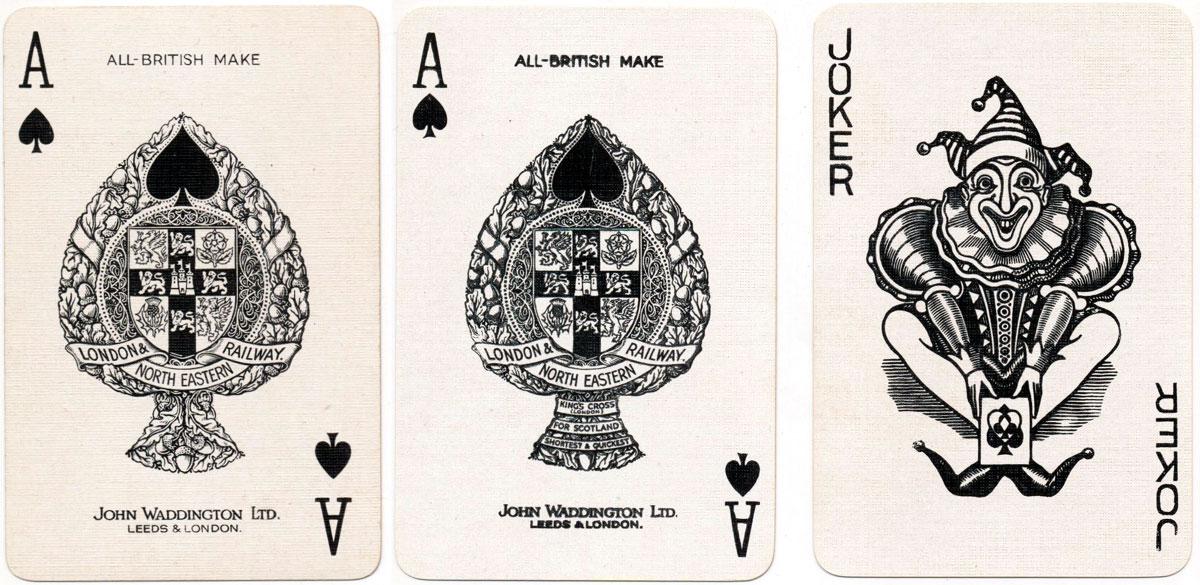
Above: two different versions of special ace of spades produced by John Waddington Ltd for the L.N.E.R.
In 1930 the caption ‘London and North Eastern Railway’ was omitted on the back and the dotted border extended around the whole card. 12 photographic scenes were issued in 1930 and again 1931 in this style, including: Westminster Bridge and Houses of Parliament, Tower and Tower Bridge, Loch Long West Highlands, Fountains Abbey, Melrose Abbey, Cambridge, the Forth Bridge, Ely Cathedral, Norwich, the Norfolk Broads, the Yorkshire Coast and York Minster. In 1933 only five of the 1930 scenes were issued and in 1935 eight of the 1930 scenes were issued.
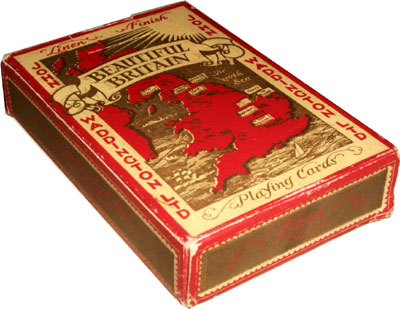
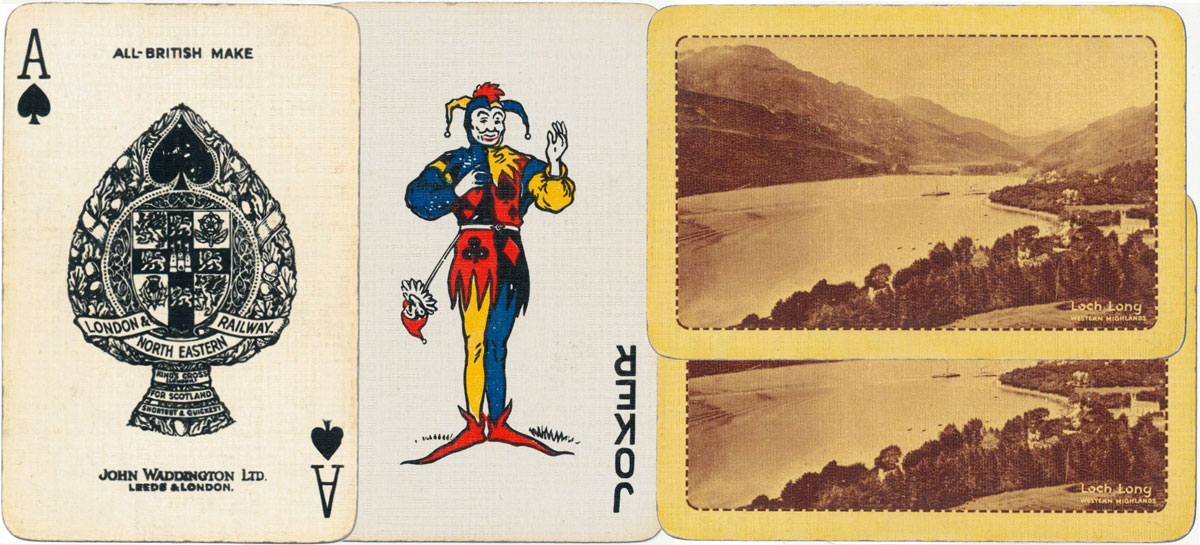
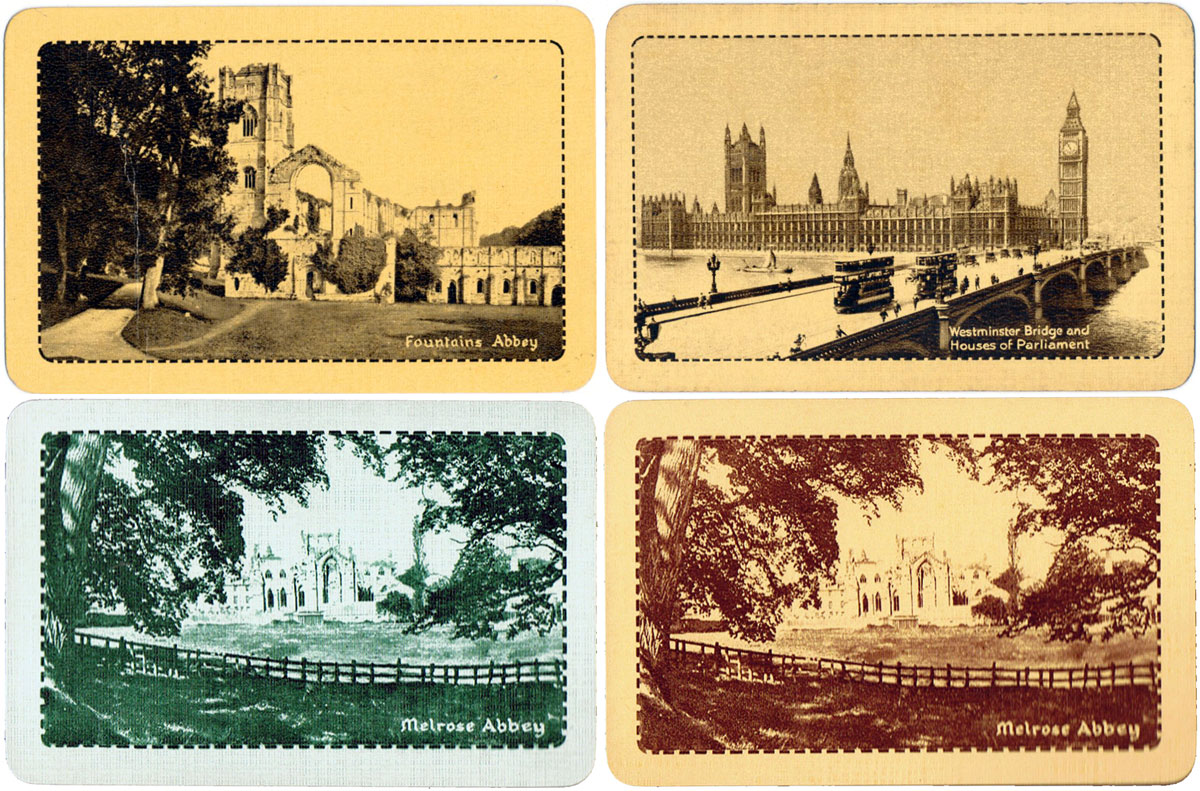

Above: ‘Beautiful Britain’ backs with continuous dotted borders, 1930-1935.
In 1938 the dotted borders were changed to a border on two sides only of 1 thick & 1 thin coloured lines and at least 16 different scenes were issued in this style, including: Norwich Cathedral, Tower and Tower Bridge, the Forth Bridge, Royal Deeside, Buckingham Palace, the Norfolk Broads, Big Ben London, Bootham Bar York, Oast House Kent, Conway Castle Wales, Bolton Abbey, Ben Nevis, Garnish Island, Glengarriff Co. Down, High Street Stratford-on-Avon, Lake District and Tower of London.

Above: ‘Beautiful Britain’ backs with thick and thin lines, 1938-39. These back designs were also published until the 1960s without the LNER aces of spades, as normal packs►
REFERENCES
Brearley, Douglas: A History of Waddingtons, in-house publication 1975-76
Welsh, R.T: ‘Beautiful Britain’ a Waddington Series, Newsletter of the English Playing Card Society, No.5 November 1984, No.6 January 1985, No.7 March 1985, No.8 May 1985 and No.10 November 1985.
Yardley, Edward: Frank Henry Mason. Marine Painter and Poster Artist, Colley Books, 2015. Page 33.
Note from Ian Taylor
There may have been a continuation of the series, still under the Beautiful Britain banner. Based on Ken Lodge's dating, the deck below is from around 1957, with a standard Waddington Ace of Spades, and W5.6 courts. Two jokers are present. Far from being a normal deck, the box is printed up as Beautiful Britain. I'm guessing there might have been more of these.


By Simon Wintle
Member since February 01, 1996
I am the founder of The World of Playing Cards (est. 1996), a website dedicated to the history, artistry and cultural significance of playing cards and tarot. Over the years I have researched various areas of the subject, acquired and traded collections and contributed as a committee member of the IPCS and graphics editor of The Playing-Card journal. Having lived in Chile, England, Wales, and now Spain, these experiences have shaped my work and passion for playing cards. Amongst my achievements is producing a limited-edition replica of a 17th-century English pack using woodblocks and stencils—a labour of love. Today, the World of Playing Cards is a global collaborative project, with my son Adam serving as the technical driving force behind its development. His innovative efforts have helped shape the site into the thriving hub it is today. You are warmly invited to become a contributor and share your enthusiasm.
Related Articles

Tangle Foot Ale
Badger Brewery Tangle Foot strong ale advertising pack.

ViVa Bourg
A distinctive deck of cards for a specific promotion.

Dancing
“Dancing” playing cards manufactured by Nintendo for Torii Dance School, Osaka.

Scientific Whist
“Scientific Whist” : standard cards with instructions for play on the faces by Chas Goodall & Son, 1...

Agent Provocateur
Branded lingerie collection in a pack of pin-up playing cards.

Shin-Tōmei Expressway Opening Commemoration
Promotional playing cards for the Shin-Tōmei Expressway, a major Japanese expressway that opened in ...

Nimbus playing cards
Mike Steer’s weather-themed pack with suits in four colours and backs for cardistry.

Agatha Christie and Playing Cards revisited
Agatha Christie uses card-play as a primary focus of a story, and as a way of creating plots and mot...

The Decadent Deck
Studies in the eroticism of the female body by Inge Clayton.

Historic Shakespeare
“Historic Shakespeare” playing cards featuring Shakespearean characters by Chas Goodall & Son.

Copechat Paramount Sorting System
Preserving the past: a specimen deck showcasing edge-notched cards and their ingenious sorting syste...

Heartsette by Herbert Fitch & Co, 1893
A glimpse into a busy print and design office in late Victorian London.

Intersigma
A Czech advertising deck for a company dealing with pump technology.

Batman® playing cards
Batman playing cards published by InterCol of London 1989.

Can You Believe Your Eyes?
“Can You Believe Your Eyes?” playing cards featuring visual illusions & other oddities.

Pastime Playing Cards for the Blind
The “Pastime” Playing Cards for the Blind manufactured by Goodall & Son Limd., c.1910.
Most Popular
Our top articles from the past 28 days





